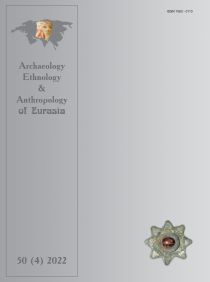
|
Archaeology, Ethnology & Anthropology
of Eurasia
50 (4) 2022
doi:10.17746/1563-0110.2022.50.4.049-057
|
Annotation:
Okunev Statues at Mount Uitag, Khakassia
E.S. Bogdanov
Institute of Archaeology and Ethnography, Siberian Branch, Russian Academy of Sciences, Pr. Akademika Lavrentieva 17, Novosibirsk, 630090, Russia
This article presents two new steles discovered in 2021 during rescue archaeological works in the Askizsky District of the Republic of Khakassia. Both steles were part of Tagar funerary enclosures. One is a slab of Devonian sandstone with an anthropomorphic mask on its broad side. It was adjacent to the southern wall of the enclosure at Skalnaya-6 mound 1. Only the outline of the head in the chin region has been preserved, as well as the mouth, modeled as a depression, and three transverse lines between the nose and the mouth. The other stele, made of red sandstone, bears a human-like profile in the lower part, carved on the edge and extending to lateral sides. This stele, unusually well preserved, was part of the northern wall of the enclosure of Uitag-3 mound 5. The article describes and interprets this laconic, realistic image of a “male shaman” wearing a three-eyed animal mask and high headgear. The two Uitag slabs differ in the placement of the face (on the broad side in one case, and on the lateral sides in the other). However, the pecking technique and the method of rendering the facial features are the same. The general stylistic manner makes it possible to attribute both artifacts to a single cultural and chronological horizon—that of the Early Okunev culture. None of the sculptures has exact matches, but in terms of style, composition, and semantics they resemble those with realistic images in relief extending from one side of the slab to another. The fragment of the statue from Uitag-3 mound 5 is the earliest realistic representation of a mask, which can possibly be used as a reference for researchers.
Keywords: Minusinsk steppe, Okunev art, mythology, statues, steles, masks